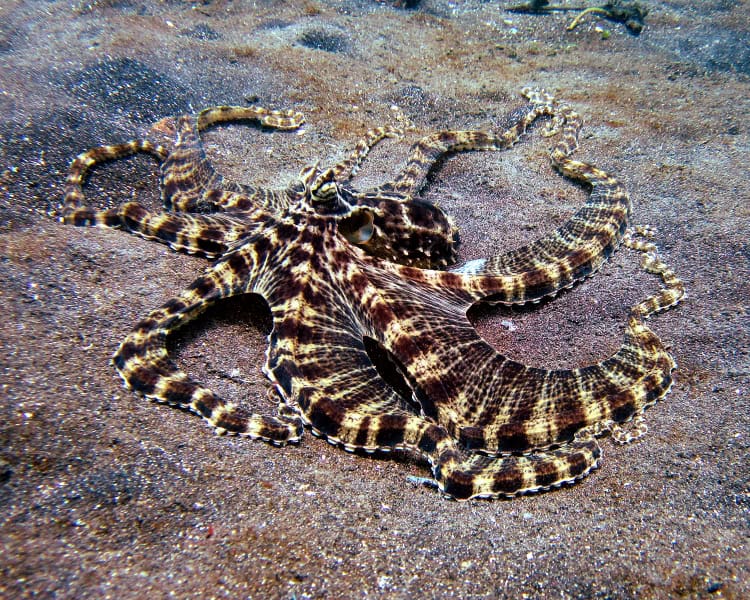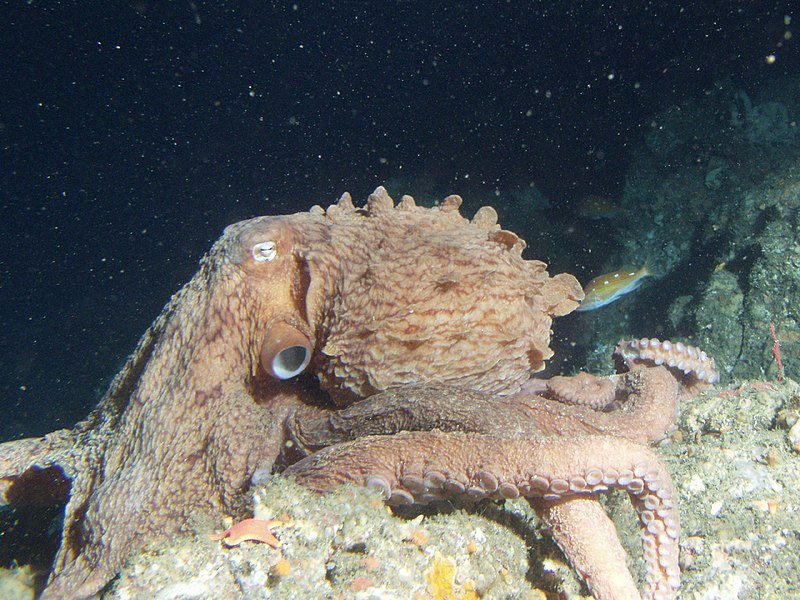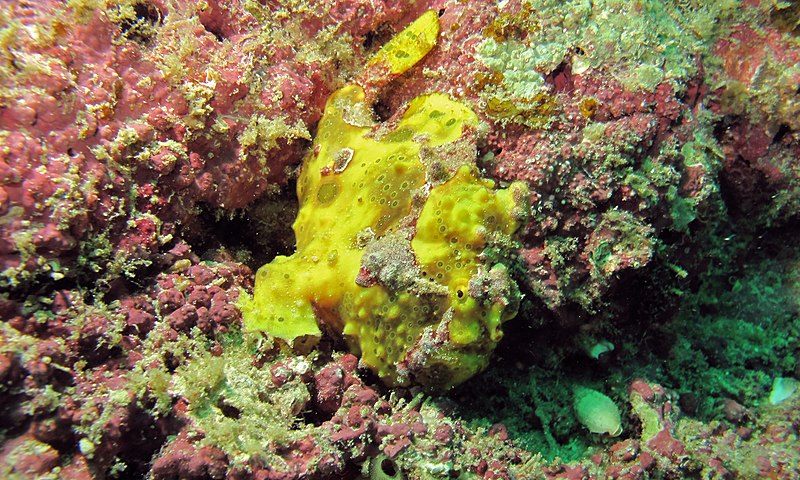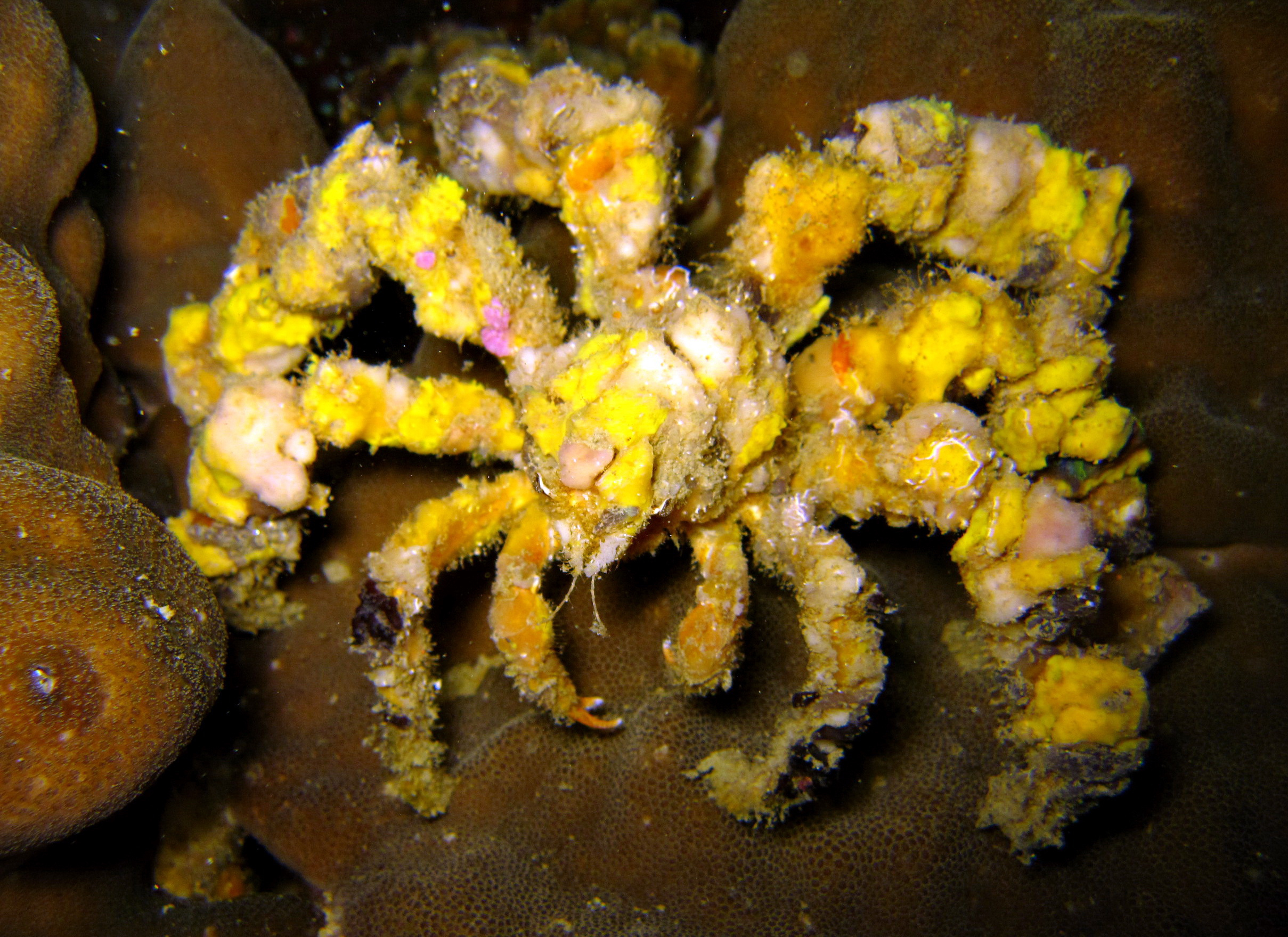The ocean is home to some of the most fascinating masters of disguise, where survival often depends on the ability to blend in. From octopuses that can change both color and texture to mimic their surroundings to tiny sea slugs that look like leaves drifting through the water, camouflage is a powerful tool for marine life. This skill allows these creatures to evade predators, ambush prey, and navigate complex habitats without being noticed. Some, like the stonefish, use it to stay hidden on rocky seabeds, while others, like the mimic octopus, take on the forms of other animals entirely. Each of these rare marine species has evolved unique ways to disappear into the underwater world, showcasing the wonders of adaptation and the mysteries of the deep.
Leafy Sea Dragon

The leafy sea dragon is a master of disguise, resembling a floating piece of seaweed with incredible detail. Native to the waters off southern and western Australia, its leaf-like appendages help it blend into kelp beds and seaweed. These “leaves” aren’t used for propulsion; instead, the dragon relies on small, nearly transparent fins to navigate stealthily through the water. With its green, brown, and yellow hues, it matches the colors of its environment perfectly. Its ability to remain motionless adds to its invisible presence, making it hard for predators to detect. Though delicate-looking, this creature is quite resilient to minor habitat changes. Such unique adaptations have made it a remarkable subject for marine researchers worldwide.
Flamboyant Cuttlefish

The flamboyant cuttlefish takes camouflage to another level with its ability to shift colors in seconds. Found in the tropical waters of the Indo-Pacific, this cuttlefish can change its skin pattern to blend in or to startle predators with vivid hues. When blending, it mimics the sandy ocean floor, making it nearly undetectable. Unlike other cuttlefish, it can sometimes walk on the ocean bed, which helps avoid drawing attention with swimming movements. Interestingly, its camouflage abilities don’t just stop at colors; it can also alter the texture of its skin to match rocky environments. It even uses bioluminescence to disappear under certain lighting conditions. This skillful camouflage helps it stay safe from both predators and prey alike.
Mimic Octopus

The mimic octopus is famous for not only blending in with its environment but also for impersonating other sea creatures. Found in the shallow waters of Southeast Asia, this clever octopus can take on the appearance of venomous creatures like lionfish, sea snakes, and even flatfish. It stretches and contracts its limbs, changing its movement and shape to imitate these animals. Using chromatophores in its skin, it shifts colors and patterns to match its chosen form. This incredible adaptability allows it to evade predators who might otherwise pursue it. Scientists were initially astounded by this octopus’s intelligence and camouflage skills. Today, it remains one of the most studied creatures in marine biology.
Giant Pacific Octopus

Known for its immense size, the giant Pacific octopus can also blend into its environment with surprising agility. This cephalopod, found in the Pacific’s cold waters, uses its chromatophores to mimic colors and patterns on coral, rocks, and the ocean floor. Its unique ability to shift not just color but also texture allows it to blend seamlessly with its surroundings. When threatened, it can vanish into rocky crevices or mimic algae-covered stones. This skill is essential, given the many predators it faces in its habitat. With an arm span reaching up to 14 feet, it’s surprising how invisible it can become. This adaptive camouflage serves as both a defensive mechanism and a tool for hunting unsuspecting prey.
Warty Frogfish

The warty frogfish is a peculiar-looking fish with exceptional camouflage abilities, perfectly suited to blend into coral reefs. Found in tropical and subtropical waters worldwide, its skin mimics the texture and color of sponges and corals, making it nearly invisible. It has a specialized lure on its head, which it uses to attract prey by mimicking small marine organisms. Unlike many fish, the frogfish doesn’t swim much; instead, it “walks” on its pectoral fins to remain undetected. Its ability to change color over time enhances its camouflage within different reef areas. With a face that seems perpetually grumpy, it remains unnoticed by both predators and prey alike. This clever adaptation helps it survive in its colorful, bustling habitat.
Stonefish

The stonefish is considered one of the most venomous fish in the ocean, but it’s also an expert at blending in with rocky seabeds. Found throughout the Indo-Pacific, its mottled brownish-gray skin matches the surrounding stones and coral almost perfectly. By lying motionless, it can go undetected by both prey and predators for long periods. Its dorsal fins contain venomous spines, providing a deadly surprise for anyone who mistakenly steps on it. This fish’s camouflage allows it to ambush small fish and crustaceans, which often come too close without realizing the danger. The stonefish’s skin even mimics algae growth, further enhancing its disguise. As a result, it has few natural enemies in the wild.
Leaf Scorpionfish

The leaf scorpionfish is a remarkable ambush predator, known for its ability to look exactly like a piece of drifting seaweed. Native to the Indo-Pacific, it uses its wavy, thin body to remain hidden among coral reefs. Its color can vary from pink to yellow to brown, allowing it to blend in with different parts of the reef. Remaining perfectly still, it waits for small fish and invertebrates to pass by, striking at just the right moment. Even its slow, swaying movements mimic seaweed, enhancing the deception. This stillness helps it avoid detection by both prey and predators. Its skin occasionally peels, shedding any accumulated algae and maintaining its leafy appearance.
Ghost Pipefish

The ghost pipefish is an elusive creature, often found near sandy seabeds or seagrass meadows where it effortlessly disappears. Its slender body and elongated snout allow it to hide among plants and debris, mimicking the delicate flow of underwater foliage. Unlike other fish, the ghost pipefish often hovers motionlessly, swaying with the current. Females have larger fins, resembling seagrass leaves, which helps conceal them further. This camouflage is essential for protecting itself from predators and for hunting small crustaceans. During breeding, it even changes color to better match the environment. As one of the more mysterious camouflaged creatures, it’s rarely spotted by divers.
Crocodile Fish

The crocodile fish is a bottom-dwelling predator with a body designed to blend seamlessly with the ocean floor. Its mottled, sand-colored skin resembles the substrate of coral reefs, allowing it to disappear entirely when lying flat. Found throughout the Indo-Pacific region, it uses this camouflage to ambush prey, remaining motionless until its target is within striking distance. Its eyes are also adapted with frilly, fringed eyelids that obscure its gaze, adding to the illusion of being part of the sea floor. This camouflage not only helps it avoid detection by prey but also protects it from larger predators. The fish’s flattened body and wide mouth further enhance its disguise. This species exemplifies nature’s mastery of blending in.
Decorator Crab

The decorator crab takes a unique approach to camouflage by actively adorning its body with materials from its surroundings. Found in various regions around the world, it attaches bits of algae, sponges, and corals onto its shell to hide from predators. By blending in with the surrounding environment, it reduces the chance of being spotted by larger marine creatures. The crab’s decorating choices even vary depending on its habitat, showing a certain level of environmental awareness. Some species of decorator crab can even change their decorations as they move between different habitats. Its dedication to disguise is so intricate that it’s often mistaken for part of the reef itself. This creative approach to camouflage makes it one of the most adaptable creatures in the ocean.
Cuttlefish

The cuttlefish is one of the most skilled marine animals when it comes to camouflage, possessing both color-changing and texture-matching abilities. With a unique set of chromatophores, it can adjust its skin tone in a split second, mimicking rocks, sand, and coral. Unlike many other animals, it can also alter the texture of its skin to add depth, making it appear bumpy or smooth depending on the surroundings. This adaptation is essential for evading predators like sharks while also helping it hunt prey undetected. Cuttlefish are known to exhibit patterns for communication as well, adding complexity to their camouflage. When disturbed, it can create startling patterns to ward off threats. Their intelligence and adaptability continue to intrigue scientists and divers alike.
Leaf Sheep Sea Slug

The leaf sheep sea slug is a small, leaf-like creature that uses its appearance to blend in with underwater foliage. Found mainly in the waters around Japan and the Philippines, this slug is often mistaken for algae. It is capable of photosynthesis, using chloroplasts from the algae it consumes to produce energy. This ability not only camouflages it as part of the surrounding plant life but also allows it to harness sunlight for survival. Its green, leafy appearance lets it remain inconspicuous, blending into seagrass beds and algae-covered rocks. This remarkable mimicry is essential for avoiding predation. Its unusual combination of photosynthesis and camouflage is a rare feat in the animal kingdom.
Weedy Seadragon

The weedy seadragon, found along the southern coastline of Australia, is a distant relative of the seahorse and shares its skill for camouflage. Its thin, leafy appendages resemble kelp, allowing it to drift undetected among the underwater foliage. This camouflage not only protects it from predators but also helps it in foraging without being seen. It has a combination of green, yellow, and red colors that perfectly match the hues of kelp beds. By remaining motionless, it becomes nearly invisible to passing fish and larger predators. Unlike other seahorses, the weedy seadragon does not have a prehensile tail, relying instead on its coloration for protection. This ability to blend seamlessly with its habitat makes it one of the most enchanting camouflaged creatures.
Pygmy Seahorse

The pygmy seahorse is a tiny marvel, blending into coral reefs so effectively that it was only discovered by researchers in the late 20th century. Native to the Indo-Pacific region, this seahorse lives on specific types of coral, which it matches in both color and texture. It can be pink, red, or even purple, depending on the color of the coral it inhabits. Its bumpy skin mimics the polyps on coral branches, creating a flawless disguise that keeps it safe from predators. Measuring just a few centimeters, its small size also helps it remain undetected. The pygmy seahorse’s incredible camouflage abilities are essential for its survival in predator-rich waters. This tiny creature exemplifies nature’s intricate adaptation mechanisms.
Leaf-Tailed Gecko

The leaf-tailed gecko is a terrestrial camouflage expert, resembling a dry leaf with uncanny accuracy. Found in the forests of Madagascar, it uses its flat, leaf-like tail to blend in with fallen leaves and tree bark. Its brown and mottled patterns are so realistic that it can remain unnoticed even when perched openly on a branch. This unique camouflage helps it avoid birds and other predators that rely on sight for hunting. The gecko’s body structure is also flattened, aiding in its mimicry of a dead leaf. It’s capable of remaining perfectly still, enhancing its camouflage to an impressive level. This incredible disguise is not only effective for avoiding predators but also for ambushing insects for food.
Spiny Lumpsucker

The spiny lumpsucker is a small, round fish with a body covered in tiny, spine-like protrusions that resemble sea anemones or barnacles. Native to the cold waters of the North Pacific, it has the ability to blend in with rocky, algae-covered areas. Its adhesive pelvic fin allows it to attach to rocks, which helps it stay in place while feeding or avoiding predators. Its color varies, often matching the rocks and coral in its surroundings, allowing it to remain hidden. When threatened, it can remain still, relying on its rough, rocky appearance to evade detection. The lumpsucker’s unusual body shape also helps it blend in with seaweeds and kelp. This adaptability in disguise is vital for its survival in predator-filled habitats.
Reef Stonefish

The reef stonefish is one of the ocean’s deadliest creatures and an expert in camouflage. It can remain still for hours, blending perfectly into rocky coral beds where it waits for unsuspecting prey. Its body is mottled and covered with bumpy textures that match the rocks and algae around it, rendering it almost invisible. It possesses venomous spines that can inflict severe pain or even be fatal to other creatures that come too close. With its quick reflexes, it can capture prey in a fraction of a second, surprising fish and invertebrates alike. This ambush tactic is effective for both feeding and defense. Its camouflage is so effective that it’s often a hazard for divers who may accidentally step on it.
Lizardfish

The lizardfish is a slender predator that lies in wait on sandy ocean floors, camouflaging itself to ambush prey. Found in warm, shallow waters worldwide, its body coloration mimics the sand and pebbles beneath, making it almost impossible to spot. Its sharp, pointed teeth allow it to quickly capture fish and invertebrates that venture too close. By lying motionless and partially buried, it becomes an invisible predator on the ocean floor. Its camouflage helps protect it from larger predators, as well. The lizardfish’s ability to match its surroundings makes it an effective ambush hunter. This fish’s unique survival strategy highlights the power of camouflage in the underwater world.
Octopus Wolfi

The octopus wolfi is one of the smallest known octopus species, reaching only about one inch in length, yet it boasts exceptional camouflage skills. This tiny octopus is found in the Indo-Pacific and can change color and pattern to blend into coral reefs and sandy bottoms. With its chromatophores, it can mimic the shades and textures of its environment almost instantly. It uses this camouflage to hide from both predators and prey, adapting its appearance depending on the threat level. Its size and flexibility allow it to hide in crevices, becoming virtually undetectable. Unlike many other octopuses, it doesn’t rely on ink for defense, as its camouflage skills are advanced enough for evasion. This tiny octopus showcases nature’s smallest yet effective disguise mechanisms.
Coral Crabs

Coral crabs are small crustaceans that are masters of blending into the reefs they inhabit. Found throughout coral reefs worldwide, these crabs use their ability to change color to match the corals they call home. Their exoskeletons often develop patterns and textures similar to the coral polyps around them, making them nearly invisible. Some species even carry bits of coral or algae on their backs for added disguise. This camouflage helps them avoid predators while also surprising prey. Coral crabs remain close to their reef structures, using them as both shelter and a source of food. Their camouflage is essential for survival in the predator-rich environments of coral reefs.
Sargassum Fish

The sargassum fish is a rare, frog-like creature that uses its unique body shape and color to blend in with floating sargassum seaweed. Found in the Atlantic Ocean, especially around the Sargasso Sea, this fish lives among the drifting seaweed where it hides from predators and ambushes small fish and crustaceans. Its mottled yellow-brown coloring mirrors the seaweed around it, making it virtually invisible in its environment. It has adapted pectoral fins that look like small legs, which it uses to “walk” through the seaweed. This close resemblance to sargassum allows it to move undetected among floating mats. Its camouflage provides both protection and an ideal platform for hunting.
This article originally appeared on Rarest.org.
More From Rarest.Org
Some vintage cars, once overlooked, have soared in value over the years, surprising collectors and enthusiasts alike. These hidden gems offer unique design, engineering, and history that have made them highly sought-after today. Read more.
The history of written language dates back thousands of years, shaping civilizations and communication as we know it today. Some of the earliest known scripts emerged from ancient cultures that developed unique ways of recording information. Read more.
Cruise ships have grown into massive floating resorts, offering luxury and adventure at sea. The largest cruise ships in the world are technological marvels, featuring incredible amenities and space for thousands of passengers. Read more.



